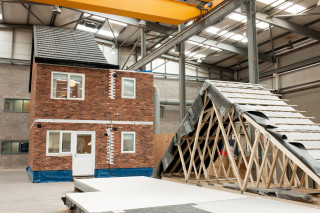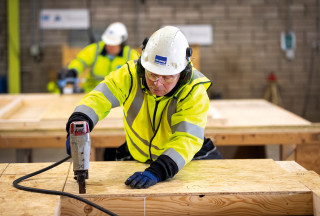A prototype house that can be assembled in a single day is doing the rounds in Northern Ireland. The sections arrive pre-decorated, with the flooring laid, kitchens and bathrooms installed. The entire process, from laying foundations to occupation takes just seven days.
The volumetric solution is the brainchild of Northern Ireland-based McAvoy Group. The offsite specialist is well established in the education, health and commercial office sectors and now making a play for the modular residential market.
Among the runners and riders offering fixes for the UK’s chronic housing shortage, McAvoy is a weighty contender. The company won BIM contractor of the year at this year’s BIM Awards, with the judges noting that McAvoy “is doing things differently” from competitors. And this is not just in its embrace of digital technology. McAvoy is challenging traditional supply chain behaviours too.
An independent family-owned business. McAvoy has been manufacturing steel-framed offsite modules – both for permanent and temporary structures – for half a century. Ten years ago the company took the strategic decision to move up the procurement ladder, from supplier to principal contractor.
McAvoy managing director Eugene Lynch says the move was triggered by the economic downturn and the need to have more control. It was also a response to the countless value-engineering exercises that each project was being subjected to which, in his view, were leading to errors and inferior outcomes.
“The principles of offsite construction were being eroded in the commercial debate. We had to take control for the sake of the future of this business,” he says, emphasising the importance of having early engagement with clients:
“If we accept the age-old rule that 80% of the costs of any project are determined at design stage, then you need to integrate design with offsite process, in order to minimise cost, and make it a smoother experience,” he says.
Early adoption of digital technology facilitates this experience. While many suppliers are still struggling to adapt to the government’s building information modelling (BIM) strategy, McAvoy was the first offsite specialist to achieve BIM level 2 accreditation.
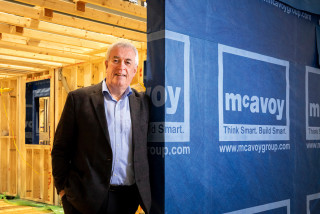
But David Clark, the company’s head of manufacturing and innovation, emphasises that BIM is much more than creating 3D models of buildings. “It’s a set of digital processes that will improve our efficiency on how we deliver our projects,” he adds.
The company takes an ‘open BIM’ approach: different parties on the project team – designers, architects, engineers and manufacturers – can use any design software product, but all files are uploaded into the system in a standardised format.
“Standardised file formats allow us to share our information, collaborate, review and interrogate and get that design element correct early. That is at the core of everything we do,” Clark adds.
Virtual reality technology is now interacting with this digital base: clients are being given VR headsets to walk around their future buildings before the ground has even been broken on site.
David Clark, McAvoy's head of manufacturing and innovation, believes the construction industry needs a stronger culture of R&D.
“They can feel and visualise their building on a one-to-one scale and can make really detailed decisions early,” Clark says.
The company has developed a “one click VR” environment, where clients can click on any part of a 3D model and be transported into the virtual space. The VR model is linked to the BIM model, used by designers and architects. If a client asks for a change – say, for a door to be moved – the design can be altered and adjusted in real time until the client is happy.
McAvoy has evolved its VR offer into a multi-user experience, where parties can be sitting in different offices, in different parts of the world, and can simultaneously enter the same VR environment through a headset.
Virtual reality was a key influencer when McAvoy was discussing a new passenger boarding zone for Dublin Airport Authority (DAA). The 19m-wide, 70m-long structure featured some of the longest modules that McAvoy has ever manufactured – up to 16.5m in length. Even so, the need to transport such large sections under motorway bridges limited the potential height of each module to little more than 4m.
This in turn limited the ceiling height to 4m. The client was worried this would be too low for such a wide-open space, remaining unconvinced that the design would work, even after watching animated fly through videos. It was only when the executives experienced the space through VR headsets that the conversation changed.
“Within seconds they got the feeling of scale and an understanding of the facility, and said ‘we don’t need to worry about it’. The whole talk around the ceiling then just stopped immediately,” Clark says.
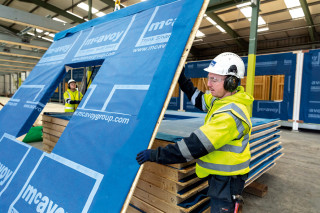
The seven-day house
McAvoy’s 95m2 prototype house was developed in collaboration with Queen’s University Belfast and Todd Architects and features a number of innovations.
Instead of concrete, which is energy-intensive and heavy to transport, the company is using a new material for its floor system. McAvoy’s head of manufacturing, David Clark, declines to go into specifics of this material, having signed a confidentiality agreement with the manufacturer. But he confirms that the recycled product is “highly sustainable” and lighter and more flexible than concrete.
“It’s a dry material that will flex and bend without any fracturing, which was the issue that we were having with concrete,” he says.
Each of the house’s six modules (including two pre-tiled roof sections) have specially designed load-bearing brackets, to ensure that they are always lifted from the top. The brackets are removed once the units are in place.
Ironically, the only element that could slow progress is the choice of external facade: cladding panels could be prefitted in the factory, but if clients prefer a rendered finish, it will have to be applied by traditional wet trades with scaffolding erected round the house.

The system’s light gauge steel frame can be reconfigured to construct multi-storey apartments. It is guaranteed for 60 years through BOPAS (Buildoffsite Property Assurance Scheme) accreditation.
But Clark admits that offsite solutions still have to work hard to counter negative customer perceptions.
“Everybody has a perception [that offsite structures] will feel a bit flimsy. We need to give people assurance that they can still live in a solid and robust asset, just built in a different way. As an industry we need to work on this.”
The company is now working on an augmented reality – or mixed reality – project with the Manufacturing Technology Centre (MTC), in which users looking through special glasses can see a 3D object superimposed on the real world. Clark believes that this could be a powerful way of engaging both planners and clients, helping them understand how the new building could fit in, and affect, its environment.
Getting early client and planning signoff is critical in helping McAvoy optimise its schedules: 3D digital designs from the BIM model can be sent immediately to the steel frame manufacturer and McAvoy can start creating its flooring, wall panels and roof sections ready to fit into the steel frame.
In parallel with the manufacturing, groundworks will also start on site as early as possible. This ensures that the foundations are ready by the time the modules are complete. Such efficiencies, Lynch says, have helped the company slash project delivery times by 40 or 50% compared to traditional site-based building.
Clark admits McAvoy’s two factories in Northern Ireland, which create the finished modules, are “not hugely automated” at present, but the company is challenging itself to see what level of automation would be most beneficial in the future. He sees a “sweet spot” somewhere between the automotive industry and traditional site-based trades.
McAvoy's factories are 'not hugely automated' admits Clark.
“We want to automate our processes but don’t want to restrict ourselves, because we have to be a flexible and agile business. For us, the challenge is how can we take the best bits out of manufacturing and the best bits from construction and bring them together to ensure we’re getting the benefits,” he says.
Lynch explains further: “We’re trying to influence the industry to believe it can do things differently. I don’t think that means a car factory mentality [but] it means a lot of the car factory thinking and aligning of processes that should bring significant productivity improvements for ourselves and the industry. Productivity improvements translate into cost reductions which translate into more affordability.”
McAvoy is also exploring how augmented reality can be harnessed in a factory setting, as an aid to more efficient working. At present Clark is frustrated by the limits of digital adoption:
“We create these fantastic three-dimensional digital models; we get it to the point that they are clash-reviewed with all of the issues resolved. Then we go back and create two-dimensional drawings, hand out paper copies to everybody. It’s a really wasteful way of doing things,” he says.
Instead, he would like to see factory technicians receiving their instructions via wearable devices or tablets in 3D.
“Over the next five to ten years, I see this is a key area for change. The way that our information is delivered to us is just going to be different,” he says.
Both Clark and Lynch point out that the offsite sector needs to be supported by a new breed of technicians that can embrace these new ways of working. Clark is calling on universities and colleges to update their approach to modern methods of construction.
“We need a different skillset – somebody who can do a little bit of everything,” he adds, explaining that the ideal technologist would combine traditional construction competences with manufacturing-based process engineering skills.
“We can’t go into the future thinking we’re going to just keep on bringing carpenters of the traditional skill base into our industry. We need to be thinking differently,” he adds.
Lynch believes that transforming McAvoy into a multi-skilled technician business is going to be one of the biggest challenges to be faced, but he has big plans for the company which he says has an order book of around £75m and is on track to hit its target of reaching £100m turnover by 2020.
The company supplies more than 85% of its products to the UK, exporting the rest to the Republic of Ireland. Although its first residential project is in Carrickfergus in Northern Ireland, Lynch believes that most of the company’s expansion into housing will be in England, where demand is highest. He hints that the company may be considering setting up a new facility there in the future.
Traditionally, education has been one of McAvoy’s most important markets and the company is currently working on five live projects in the sector. Lynch praises the Department for Education’s “visionary” approach as a “significant early adopter” of modern methods of construction. He adds that the health sector, while organised completely differently, is also growing in its use of offsite.
Nevertheless, Lynch says the industry must navigate a complex landscape of opportunities and threats before the offsite sector can really move forward. Perhaps the biggest threat is the lack of continuity of work, which interrupts investment and research and “very seriously erodes the prospect of attracting new employees into factory environments”.
But, with offsite accounting for a maximum of 15% of the entire construction market, he also sees lack of industry understanding of the sector’s potential benefits as a major threat to the growth of the offsite eco-system. He also cautions that lack of capability within the sector itself will cause problems: “We can’t allow under-performance to prevail because that damages confidence and sets everything back.”
Clark believes that construction needs to create a stronger culture of research and development, commenting that most of construction is “dramatically lagging behind other sectors”.
“At McAvoy, digital is core to everything we do. Our biggest challenge is actually staying on top of that because it changes every day,” he adds.
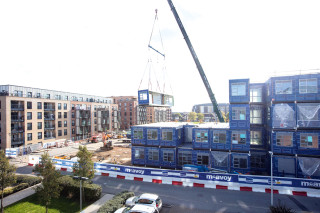
This article was first published in the April 2019 issue of The Construction Index magazine
UK readers can have their own copy of the magazine, in real paper, posted through their letterbox each month by taking out an annual subscription for just £50 a year. Click for details.
Got a story? Email news@theconstructionindex.co.uk

